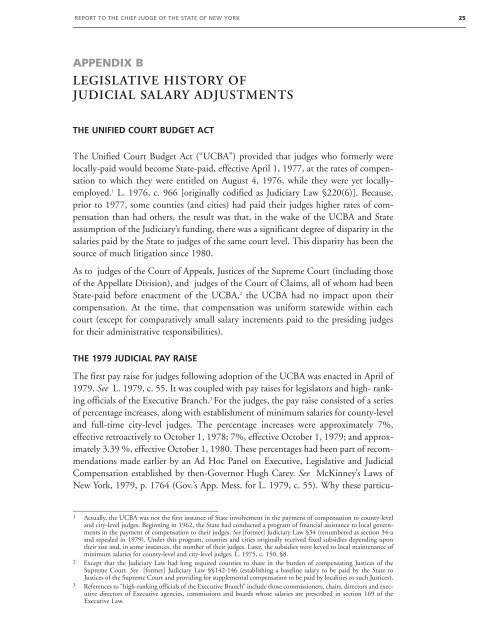Judicial Compensation in New York: A National Perspective, Report
Judicial Compensation in New York: A National Perspective, Report
Judicial Compensation in New York: A National Perspective, Report
Create successful ePaper yourself
Turn your PDF publications into a flip-book with our unique Google optimized e-Paper software.
REPORT TO THE CHIEF JUDGE OF THE STATE OF NEW YORK 25<br />
APPENDIX B<br />
LEGISLATIVE HISTORY OF<br />
JUDICIAL SALARY ADJUSTMENTS<br />
THE UNIFIED COURT BUDGET ACT<br />
The Unified Court Budget Act (“UCBA”) provided that judges who formerly were<br />
locally-paid would become State-paid, effective April 1, 1977, at the rates of compensation<br />
to which they were entitled on August 4, 1976, while they were yet locallyemployed.<br />
1 L. 1976, c. 966 [orig<strong>in</strong>ally codified as Judiciary Law §220(6)]. Because,<br />
prior to 1977, some counties (and cities) had paid their judges higher rates of compensation<br />
than had others, the result was that, <strong>in</strong> the wake of the UCBA and State<br />
assumption of the Judiciary’s fund<strong>in</strong>g, there was a significant degree of disparity <strong>in</strong> the<br />
salaries paid by the State to judges of the same court level. This disparity has been the<br />
source of much litigation s<strong>in</strong>ce 1980.<br />
As to judges of the Court of Appeals, Justices of the Supreme Court (<strong>in</strong>clud<strong>in</strong>g those<br />
of the Appellate Division), and judges of the Court of Claims, all of whom had been<br />
State-paid before enactment of the UCBA, 2 the UCBA had no impact upon their<br />
compensation. At the time, that compensation was uniform statewide with<strong>in</strong> each<br />
court (except for comparatively small salary <strong>in</strong>crements paid to the presid<strong>in</strong>g judges<br />
for their adm<strong>in</strong>istrative responsibilities).<br />
THE 1979 JUDICIAL PAY RAISE<br />
The first pay raise for judges follow<strong>in</strong>g adoption of the UCBA was enacted <strong>in</strong> April of<br />
1979. See L. 1979, c. 55. It was coupled with pay raises for legislators and high- rank<strong>in</strong>g<br />
officials of the Executive Branch. 3 For the judges, the pay raise consisted of a series<br />
of percentage <strong>in</strong>creases, along with establishment of m<strong>in</strong>imum salaries for county-level<br />
and full-time city-level judges. The percentage <strong>in</strong>creases were approximately 7%,<br />
effective retroactively to October 1, 1978; 7%, effective October 1, 1979; and approximately<br />
3.39 %, effective October 1, 1980. These percentages had been part of recommendations<br />
made earlier by an Ad Hoc Panel on Executive, Legislative and <strong>Judicial</strong><br />
<strong>Compensation</strong> established by then-Governor Hugh Carey. See McK<strong>in</strong>ney’s Laws of<br />
<strong>New</strong> <strong>York</strong>, 1979, p. 1764 (Gov.’s App. Mess. for L. 1979, c. 55). Why these particu-<br />
1 Actually, the UCBA was not the first <strong>in</strong>stance of State <strong>in</strong>volvement <strong>in</strong> the payment of compensation to county-level<br />
and city-level judges. Beg<strong>in</strong>n<strong>in</strong>g <strong>in</strong> 1962, the State had conducted a program of f<strong>in</strong>ancial assistance to local governments<br />
<strong>in</strong> the payment of compensation to their judges. See [former] Judiciary Law §34 (renumbered as section 34-a<br />
and repealed <strong>in</strong> 1979). Under this program, counties and cities orig<strong>in</strong>ally received fixed subsidies depend<strong>in</strong>g upon<br />
their size and, <strong>in</strong> some <strong>in</strong>stances, the number of their judges. Later, the subsidies were keyed to local ma<strong>in</strong>tenance of<br />
m<strong>in</strong>imum salaries for county-level and city-level judges. L. 1975, c. 150, §8.<br />
2 Except that the Judiciary Law had long required counties to share <strong>in</strong> the burden of compensat<strong>in</strong>g Justices of the<br />
Supreme Court. See [former] Judiciary Law §§142-146 (establish<strong>in</strong>g a basel<strong>in</strong>e salary to be paid by the State to<br />
Justices of the Supreme Court and provid<strong>in</strong>g for supplemental compensation to be paid by localities to such Justices).<br />
3 References to “high-rank<strong>in</strong>g officials of the Executive Branch” <strong>in</strong>clude those commissioners, chairs, directors and executive<br />
directors of Executive agencies, commissions and boards whose salaries are prescribed <strong>in</strong> section 169 of the<br />
Executive Law.
















